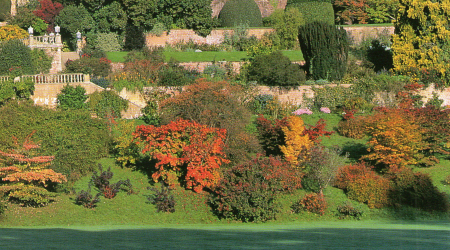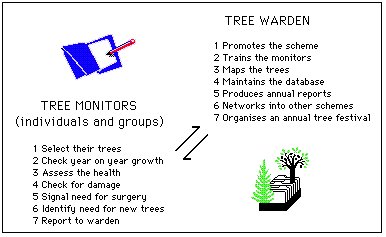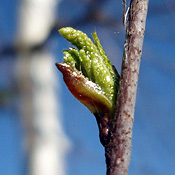
A Simple Neighbourhood Tree Diary

Objective
To establish a neighbourhood scheme, led by schools, for year on year monitoring of growth and health of trees in the community, and identifying needs for new plantings, and celebrating the life of trees.
Organisation
The basic neighbourhood organisation consists of a tree warden who is responsible for identifying and sustaining individuals or groups in a neighbourhood, the tree monitors, who take responsibility for annual checks on local trees (Fig 1). Each neighbourhood group should produce a management plan which includes all aspects of the work, and keep it up to date.*
Where a school is taking the lead the wardenship is embodied in the activity of a particular class that is engaged in the project.
Fig 1 TreeSCAN: the basic organisation

It is envisaged that the establishment of neighbourhood organisations would be integrated with school projects in November, preferably to coincinde with National Tree Week.
Yearly monitoring cycle
November National Tree Week
(i) Select trees
A community of trees (native and ornamental; parks, roadsides, gardens and school grounds) is identified and each tree recorded on a large scale map of the neighbourhood to create a tree-trail. The latter may be used as a focus for annual celebrations of 'trees in the community'. This means 'all trees', native and ornamental. For the latter it will be necessary to identify the variety. Varieties are important in that they provide a genetic standard for making long-term comparisons from place to place. A minimum of 5 trees of the same species/variety are necessary for year to year statistical comparisons
(ii) Characterise trees
The character of the tree is assessed using the SCAN 'identikit'* which categorises shape and size. Ideally, each tree should be photographed.
(iii) Plant trees
November is the conventional time for tree planting- hence the timing of National Tree Week. To enable new plantings to be included in the National Phenology Network- and organisation to define biological indicators of climate change- it is important to plant native species. It is preferable that these trees are large enough to avoid problems of vandalism/weeding, and obtain information on flowering. The following list contains the core species for checking climate change. They all have flowers and berries and have a range of species and cultivars which helps in comparative databasing of year to year, and place to place, differences in seasonality and productivity.
Crab;
Thorn
Rowan
Cherry
Spring
Make a diary of of leaving/flowering
September
Health check
A detailed appraisal of the health of each tree is carried out using an educational version of the national survey procedures of the Forestry Commission, entering the information for each tree on a standard form.*
In addition, the level of insect damage is assessed on freshly fallen leaves from the position and of damage and/or position of holes, using the procedure devised by University of Wales' entomologists.*
Where, week to week observations are possible, an additional check may be used to record the timing of leaf fall.
* Backup resources will be available from SCAN in October 2000 as computer files from which recording forms may be printed. PinPoint educational software is recommended
A basic TreeSCAN diary
For..................................................................................School

Birch bud burst: Colour of leaves visible through openings in swollen bud
First Leaf: Leaf fully open
First Flower: Centre of flower visible. For aggregations of flowers as in hawthorn, rowen, or cherry, this is the date when the first individual flowers open.
Full Flower: 90% or more of flowers open, but before first flowers wither
'A' Index: Estimate the abundance of flowers or fruit. 0 = No flowers or fruit
1 = Very few flowers: 2 = Many flowers; 3 = Tree covered with flowers
1 = Very little fruit; 2 = Much fruit; 3 = Tree covered with fruit.
Girth: Circumference in cm at 1.0 metre from the ground
Height: Distance from base to highest twigs of the tree. A mehod is availble in the Acrotree resource file.
First Leaf Fall: Date in Autumn when leaves begin to accumulate at the base of the tree
Last Leaf Fall: Date when 90% or more of the leaves have fallen
More About Trees
This is a pdf version of the book by Colin Tubbs on the management history of the New Forest.
This is a text/picture guide to British trees shrubs
More About Neighbourhood Surveys
Schools and Community Agenda21 Network
This is a compendium of ideas for students to help make environmental improvements in the community served by their school